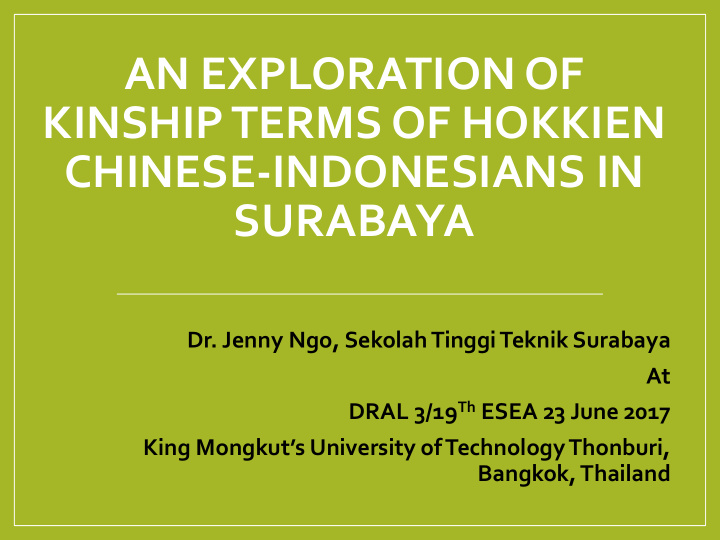



AN EXPLORATION OF KINSHIP TERMS OF HOKKIEN CHINESE-INDONESIANS IN SURABAYA Dr. Jenny Ngo, SekolahTinggi Teknik Surabaya At DRAL 3/19 Th ESEA 23 June 2017 King Mongkut’s University of Technology Thonburi, Bangkok, Thailand
A brief introduction: Indonesia • The largest archipelago in the world: more than 1300 islands • The fourth most populous country in the world: more than 250 millions in 2015 (World Bank) • The most diverse nation of more than 300 ethnic groups (Javanese 41%; Chinese 1.2%) • Language: Bahasa Indonesia (official), and 700 local dialects 1 – 2
Introduction • Chinese people living in Indonesia are as a result of overseas Chinese migration mainly from Fujian (Fukien/Hokkien) and Guangdong (Kwantung) provinces. • There are roughly nine million Chinese Indonesians throughout the archipelago, more than 240 thousands living in East Java including Surabaya. • There seems to have been little attempt at dealing with kin terms in Chinese dialects like Hokkien . More specifically, Hokkien Chinese- Indonesian in Surabaya, has rarely been subject to studies of this nature. 1 – 3
Review of Literature • Language and society (Sociolinguistics) • Language and culture. • Language shift: Bahasa Indonesia is used as the official language both at schools and offices. • Language loss is caused by loss in minority and migrant communities. 1 – 4
Objective • Underlining the significance of such studies in the wider linguistic and anthropological contexts, this study explores kinship terms Hokkien Chinese Indonesia speakers use to refer to or address their family and relatives. • This study also investigates the changes on the kinship terms used by the first and second generation of Hokkien Chinese-Indonesians in Surabaya. 1 – 5
Data & Methodology • A questionnaire with 3 sections -demographics -kinship terms in family -kinship terms in paternal & maternal relations • Open-ended questions - advantages: researchers will be able to collect exact answers -limitation: the study takes too much time 1 – 6
Data & Methodology (Cont.) • Short interview (if needed) -when the respondents used different kinship terms than the other respondents. Example: ”why do you address your mother’s parents as gua-kong (grandpa) and gua-ma (grandma)? -helpful in finding out more the traditions. • Target groups & places -Hokkien Chinese Indonesians in Surabaya - Pabean and Kapasan traditional Chinese markets. 1 – 7
Data & Methodology (Cont.) • Sample -Total: 50 respondents -First generation: 20 respondents -Second generation: 30 respondents Data completed in 12 weeks, Oct 1 – Dec 18, 2016 • Challenges -Find which stores owned by Hokkien Chinese Indonesians in the two markets -Find respondents from the first generation (pretty old, age between 60-66 yo). 1 – 8
Demographic distribution • Of the 50 respondents, 62% are male and 38% female. • The majority of respondents are between 40 and 66 years old. • 40% of the respondents are from the first generation and 60% from the second generation. • Most of the respondents are merchants. 1 – 9
Result: Table 1: Within Family Relationship First generation Second generation Parents Father papa or a-pa papa Mother mama or a-ma mama Siblings Elder brother ko-ko or a-hia ko-ko Elder sister ci-ci ci-ci Younger brother ti first name Younger sister me first name In-laws Elder brother’s wife so so or ci+first name Elder sister’s husband ci hu or first name+ko first name+ko Younger brother’s wife ti fu first name Younger sister’s husband me fu first name 1 – 10
Result: Table 2: Paternal relations Relationship First generation Second generation Grandparents Father’s father a-kong a-kong Father’s mother a-ma a-ma Uncles and aunties Father’s elder brother peh peh Father’s elder brother’s a-em a-em wife Father’s elder sister a-ko a-ko Father’s elder sister’s ko-tiu ko-tiu husband Father’s younger brother cek cek Father’s younger brother’s en-cim en-cim wife Father’s younger sister a-ko a-ko Father’s younger sister’s ko-tiu ko-tiu husband Cousins Elder male cousin ke-pak ko or dang ko ko Elder female cousin ke-pak ci or dang ci ci Younger male cousin ke-pak ti or dang ti first name Younger female cousin ke-pak me or dang me first name 1 – 11
Result: Table 3: Maternal relations Relationship First generation Second generation Grandparents Mother’s father gua-kong gua-kong Mother’s mother gua-ma gua-ma Uncles and aunties Mother’s elder brother ku ku Mother’s elder brother’s kim kim wife Mother’s elder sister i i Mother’s elder sister’s i-tiu i-tiu husband Mother’s younger brother ku ku Mother’s younger kim kim brother’s wife Mother’s younger sister i i Mother’s younger sister’s i-tiu i-tiu husband Cousins Elder male cousin piau-ko ko Elder female cousin piau-ci ci Younger male cousin piau-ti first name Younger female cousin piau-me first name 1 – 12
Conclusions • Identify 38 kinship terms • Indicate some changes on the use of kinship terms between the first and second generation - Second generation don’t call their cousins by dang (paternal) and piau (maternal). -They address their elder cousins by ko (male) or ci (female) and their younger cousins by name. -The change shows intimacy among cousins but create ambiguity. • Four important factors influencing kinship terms: age, generation, sex, paternal & maternal relations 1 – 13
Future study • Limitation - Only 50 respondents of Hokkien Chinese Indonesians in Surabaya • Future study -Expansive investigation in terms of sample sizes -Comparative study of different cities (Surabaya and other cities) -Extension study: third generation 1 – 14
Recommend
More recommend